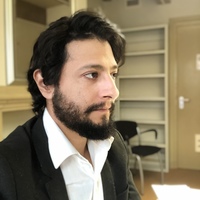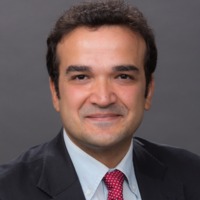Videos by Francesco Chiabotti
A Fès, au milieu du 19e siècle, vit Muḥammad ibn Abī al-Qāsim al-Qandūsī : maître soufi peu connu... more A Fès, au milieu du 19e siècle, vit Muḥammad ibn Abī al-Qāsim al-Qandūsī : maître soufi peu connu, de type malamātī puis exatique vers la fin de sa vie, il exerce le métier d’herboriste et de copiste dans le souk de Fès. Le style de ses calligraphies, géant, inédit, attire vers lui l’attention des vizirs et celle des artisans de la ville. Le nom de Dieu « Allah » peint sur un tableau géant est encore exposé dans la zaouia de Moulay Idris. Mais qui était l’homme qui réalisa cette œuvre extraordinaire ? L’univers spirituel d’al-Qandūsī est parsemé de visions du prophète Muḥammad, grâce à une connexion spirituelle permanente avec celui-ci. Nous explorerons ce lien inédit entre le Prophète et son calligraphe : comment al-Qandūsī a pu, symboliquement, peindre le Prophète ? Nous reconstruirons la vie de ce maître en nous appuyant sur des images inédites et surprenantes.
(conférence donnée dans le cadre des événements de la Fondation Conscience Soufie) 23 views
Books by Francesco Chiabotti
Arabic translation of our article published in Arabica (2014)

Qui est le Prophète Muhammad ? On l’a décrit de bien des manières : fondateur d’une communauté, l... more Qui est le Prophète Muhammad ? On l’a décrit de bien des manières : fondateur d’une communauté, législateur et juge, chef de guerre et conquérant. Il est tout cela, mais il a d’abord été un homme en attente de Dieu, puis un prophète recevant la Révélation et la transmettant à ses adeptes. Il partage aussi sa vie entre ses femmes, sa famille et ses compagnons, prêchant par son exemple et ses enseignements, se retirant la nuit avec son Seigneur. Pour ses proches et ses compagnons qui l’entourent de leur amour et de leur vénération, toute sa personne, ses paroles et ses gestes sont sacralisés par la Révélation et la visite de l’Ange.
C’est de cette vision du Prophète, telle qu’elle a été transmise par sa communauté et vécue par elle à travers les siècles, que Denis Gril a voulu rendre compte à partir des sources musulmanes traditionnelles : le Coran, les hadiths, la Sîra ou Vie du Prophète. Les études réunies dans ce volume montrent ainsi comment les spirituels de l’islam ont trouvé dans le Prophète Muhammad leur modèle en se fondant sur leurs sources scripturaires. Ce livre est une invitation à porter un autre regard sur l’islam et ses prolongements dans la tradition spirituelle du soufisme, notamment à travers l’oeuvre du grand maître andalou, Ibn al-‘Arabî, très attaché à l’étude et la transmission de la tradition prophétique et inspirateur d’une doctrine pour laquelle la réalité spirituelle du Prophète est la cause et l’accomplissement de l’humanité.
Islamologue, Denis Gril est professeur émérite à Aix-Marseille Université et membre de l’Institut de recherches et d’études sur le monde arabe et musulman. Ses recherches portent sur l’oeuvre d’Ibn al-‘Arabî, sur l’histoire du soufisme et de la sainteté en islam.
Textes recueillis et introduits par Francesco Chiabotti

This work presents an edition and study of a new manuscript document, the Amālī in hadith (dictat... more This work presents an edition and study of a new manuscript document, the Amālī in hadith (dictation sessions) of the prominent theologian and Sufi master ʻAbd al-Karīm al-Qushayrī (376-465/986-1072). Discussing both the text and the history of its transmission between the 11th and the 13th centuries C.E., in a geographical area covering the regions of Khorasan and Great Syria, the authors contribute to the understanding of the connection between Sufism and hadith culture. One of the most contributing factors to the consolidation of Sufism’s role in Medieval Islamic societies was its connection with hadith culture, both in terms of its networks and methods of transmission. The sources currently available – and to a lesser extent the studies produced to date – all attest to the idea that Sufism formed, notwithstanding, a solid binomial with hadith. In this building process, and despite some severe criticism, Sufism emerged as an important agent. Nevertheless, if we want to gain a deeper understanding of this relationship, the edition of new sources remains a pressing desideratum. Accordingly, the present work provides the scholarly community with a new document that may prove to be a significant contribution to the field.
"يقدّم هذا الكتيّب طرحًا جديدًا للعلاقة بين الحديث النبويّ والتصوّف، وذلك من خلال دراسة مصدرٍ جدي... more "يقدّم هذا الكتيّب طرحًا جديدًا للعلاقة بين الحديث النبويّ والتصوّف، وذلك من خلال دراسة مصدرٍ جديد، وهو مخطوط موجود في مكتبة جامعة لايبزغ في ألمانيا بعنوان: جزء فيه قصّة العبّاس بن حمزة مع ذي النون المصريّ رحمة الله عليه. وكما يظهر من العنوان، يرصد المخطوط زيارة أبي الفضل العبّاس بن حمزة بن أشوش النيسابوريّ لذي النّون المصريّ المتصوّف المشهور. وتبيّنُ هذه القصّة الفرق بين الطريقة السائدة في رواية الحديث وبين رواية ما يُسمّى «حديث الرقاق»، الأمر الّذي يُساهم في دحض الاتهامات الّتي تُضعف من رواية الزهّاد والمتصوّفة للحديث النبويّ."

Edited by Francesco Chiabotti, Eberhard Karls University, Eve Feuillebois–Pierunek, Sorbonne Nouv... more Edited by Francesco Chiabotti, Eberhard Karls University, Eve Feuillebois–Pierunek, Sorbonne Nouvelle Paris 3 and Laboratoire d’Etudes sur les Monothéismes, Catherine Mayeur-Jaouen, Institut national des langues et civilisations orientales and Institut Universitaire de France and Luca Patrizi
The notion of adab is at the heart of Arab-Islamic culture. Born in the crucible of the Arabic and Persian civilization, nourished by Greek and Indian influences, this polysemic notion could cover a variegated range of meanings: good behavior, knowledge of manners, etiquette, rules and belles-lettres and finally, literature. This collection of articles tries to explore how the formulations and reformulations of adab during the first centuries of Islam engage with the crucial period of the first great spiritual masters, exploring the importance of normativity, but also of transgression, in order to define the rules themselves. Assuming that adab is ethics, the articles analyse the genres of Sufi adab, including manuals and hagiographical accounts, from the formative period of Sufism until the modernity. Contributors are: Alberto F. Ambrosio, Nelly Amri, Francesco Chiabotti, Rachida Chih, Ralf Elger, Eve Feuillebois-Pierunek, Maria Chiara Giorda, Denis Gril, Paul L. Heck, Nathan Hofer, Ahmet T. Karamustafa, Annabel Keeler, Pierre Lory, Catherine Mayeur-Jaouen, Erik S. Ohlander, Samuela Pagani, Luca Patrizi, Michele Petrone, Stefan Reichmuth, Lloyd Ridgeon, Elisha Russ-Fishbane, Florian Sobieroj, Renaud Soler, Jean-Jacques Thibon, Mikko Viitamäki.
dissertation by Francesco Chiabotti

This dissertation is the first monograph on the life and work of the immensely influential Nishap... more This dissertation is the first monograph on the life and work of the immensely influential Nishapuri Sufi and theologian ʿAbd al-Karīm b. Hawāzim al-Qushayrī (376-465/986-1072). On the basis of unpublished manuscripts and textual marginalia (isnāds, ijāzas and colophons) as well as recently published critical editions, the present study has three primary research nodes: 1) Qushayrī’s formation as a thinker and the dynamics that made for the successful diffusion of his work; 2) the Qushayrian corpus (a survey of extant manuscripts, editions and secondary scholarship); and 3) the most important aspects of Qushayrī’s project.
A number of important questions will be pursued, including: How should we understand the interplay between exoteric and esoteric knowledge that pervades Qushayrī’s writings? To what extent does
Qushayrī redefine the spiritual and scholarly traditions he inherited, and how does he conceive of his role as transmitter? Finally, this study addresses the role of Qushayrī as a spiritual master. Questioning previous assumptions as to the ways in which Qushayrī’s spiritual influence was propagated, I demonstrate
that Qushayrī emerged as a charismatic spiritual master in his own lifetime, directly establishing a Sufi scholarly
tradition that our sources term Qushayriyya.
Papers by Francesco Chiabotti
Journal of Islamic Studies, 2015
The Presence of the Prophet in Early Modern and Contemporary Islam. Volume 1, The Prophet Between Doctrine, Literature and Arts: Historical Legacies and Their Unfolding, 2021
Scholarly correspondences--a window into the DNA of scholarship: The case of Rudolf Strothmann
http://www.ihu.unisinos.br/188-noticias/noticias-2018/579634-o-eremita-e-a-escrava
http://www.osservatoreromano.va/fr/news/lermite-et-lesclave
http://www.osservatoreromano.va/en/news/hermit-and-slave-woman
Journals of the Muhyiddin Ibn 'Arabi Society, 65, 2019

The Amālī of Abū l-Qāsim al-Qushayrī: An Edition and Study of Codex Ẓāhiriyya 1135
Bilal Orfali... more The Amālī of Abū l-Qāsim al-Qushayrī: An Edition and Study of Codex Ẓāhiriyya 1135
Bilal Orfali
Professor of Arabic and Islamic Studies, American University of Beirut
bilal.orfali@aub.edu.lb
Francesco Chiabotti
Associate Professor of Islamic Studies, INALCO, Paris
francesco.chiabotti@inalco.fr
Abstract: This article presents an edition and study of a new manuscript document, the Amālī in hadith (dictation session) of the prominent theologian and Sufi master ʿAbd al-Karīm al-Qushayrī (376-465/986-1072). Discussing both the text and the history of its transmission between the 11th and the 13th centuries C.E., in a geographical area covering the regions of Khorasan and Great Syria, the authors contribute to the understanding of the connection between Sufism and hadith culture. One of the most contributing factors to the consolidation of Sufism’s role in Medieval Islamic societies was its connection with hadith culture, both in terms of its networks and methods of transmission. The sources currently available – and to a lesser extent the studies produced to date – all attest to the idea that Sufism formed, notwithstanding, a solid binomial with hadith. In this building process, and despite some severe criticism, Sufism emerged as an important agent. Nevertheless, if we want to gain a deeper understanding of this relationship, the edition of new sources remains a pressing desideratum. Accordingly, the present article provides the scholarly community with a new document that may prove to be a significant contribution to the field.
Keywords:
Sufism, hadith, dictation sessions, Qushayrī.
يشتمل هذا البحث على تحقيق لمخطوط الأمالي في الحديث وعلى دراسة له، وهو لشيخ المتصوّفين وإمامهم عبد الكريم القشيري (376-465/986-1072). وهدف البحث إغناء فهمنا ومقاربتنا للعلاقة بين التصوّف وعلم الحديث، وذلك انطلاقًا من دراسة النصّ والسياق التاريخيّ لتداوله بين القرنَين الحادي عشر والثالث عشر الميلاديّين، ضمن بقعةٍ جغرافيّة تضمّ خراسان وبلاد الشام. وإنّ من أبرز العوامل التي كرّست دور التصوّف في المجتمع الإسلاميّ حينها، ارتكازه إلى علم الحديث من جهتي شبكة العلاقات [بين رجاله] وطريقة الإسناد. لكنّ المصادر التي بين أيدينا – وكذلك الدراسات إلى حدٍّ ما – تؤكّد أنّ التصوّف قد شكّل مع الحديث معادلةً ثنائيّة. وفي أثناء تشكّل هذه المعادلة، ورغم الانتقادات اللاذعة التي واجهتها، برز التصوّف عاملًا مهمًّا بحدّ ذاته. ولكن يبقى الكشف عن مصادر جديدة مطلبًا ملحًّا يجيز لنا فهم العلاقة التي تجمع التصوّف بعلم الحديث على نحو أدقّ وأعمق. ويضع مقالنا هذا في متناول الباحثين مادّةً جديدةً قد تكون ذات أهمّيّةٍ بالغة.

TRIVIUM, 2019
Das vorliegende Themenheft der Zeitschrift Trivium ist im Zuge des deutsch-französischen ANR-DFG-... more Das vorliegende Themenheft der Zeitschrift Trivium ist im Zuge des deutsch-französischen ANR-DFG-Projekts »PROPHET – Muhammad im Spiegel seiner Gemeinschaft im frühmodernen und modernen Islam« entstanden. Die Auswahl der übersetzten Texte spiegelt die Geschichte und die unterschiedlichen Ansätze der französischen und der deutschen Islamforschung wider, insbesondere jener Forschung, die der Figur des Propheten des Islams gewidmet ist. Schwerpunkt des Themenheftes sind die Prozesse, die im Laufe der Zeit zunächst zur Sakralisierung der Figur des Propheten, danach zu deren Infragestellung geführt haben. Anhand der ausgewählten Artikel, die erstmals nun in beiden Sprachen zur Verfügung stehen, sollen Forschungsfragen und methodologische Diskussionen zum Islam in Europa zusammengeführt und bereichert werden.
Diese Publikation wurde gefördert durch die Fritz Thyssen Stiftung (Köln), die Éditions de la Maison des sciences de l'homme und die Délégation générale à la langue française et aux Langues de France (Paris).

TRIVIUM, 2019
Ce numéro de Trivium est né dans le sillage du projet franco-allemand ANR/DFG « PROPHET – Muhamma... more Ce numéro de Trivium est né dans le sillage du projet franco-allemand ANR/DFG « PROPHET – Muhammad au miroir de sa communauté dans l'islam moderne et contemporain ». Le choix des articles traduits reflète les approches et l’histoire respectives de la recherche française et allemande en islamologie, plus particulièrement la recherche qui concerne la figure prophétique en islam. Ce dossier thématique met l’accent sur les procédés qui ont conduit, à travers le temps, d’abord à la sacralisation de la figure prophétique, ensuite à sa remise en cause. Il rend disponible pour la première fois dans les deux langues un ensemble de textes qui contribueront, en soulevant également des débats d’ordre méthodologique, à rapprocher et à enrichir les questionnements autour de l’islam en Europe.
Ce numéro a été réalisé avec l’aide de la Délégation générale à la langue française et aux langues de France (Ministère de la Culture), des Éditions de la Maison des sciences de l'homme et de la Fondation Fritz Thyssen (Cologne).











Uploads
Videos by Francesco Chiabotti
(conférence donnée dans le cadre des événements de la Fondation Conscience Soufie)
Books by Francesco Chiabotti
C’est de cette vision du Prophète, telle qu’elle a été transmise par sa communauté et vécue par elle à travers les siècles, que Denis Gril a voulu rendre compte à partir des sources musulmanes traditionnelles : le Coran, les hadiths, la Sîra ou Vie du Prophète. Les études réunies dans ce volume montrent ainsi comment les spirituels de l’islam ont trouvé dans le Prophète Muhammad leur modèle en se fondant sur leurs sources scripturaires. Ce livre est une invitation à porter un autre regard sur l’islam et ses prolongements dans la tradition spirituelle du soufisme, notamment à travers l’oeuvre du grand maître andalou, Ibn al-‘Arabî, très attaché à l’étude et la transmission de la tradition prophétique et inspirateur d’une doctrine pour laquelle la réalité spirituelle du Prophète est la cause et l’accomplissement de l’humanité.
Islamologue, Denis Gril est professeur émérite à Aix-Marseille Université et membre de l’Institut de recherches et d’études sur le monde arabe et musulman. Ses recherches portent sur l’oeuvre d’Ibn al-‘Arabî, sur l’histoire du soufisme et de la sainteté en islam.
Textes recueillis et introduits par Francesco Chiabotti
The notion of adab is at the heart of Arab-Islamic culture. Born in the crucible of the Arabic and Persian civilization, nourished by Greek and Indian influences, this polysemic notion could cover a variegated range of meanings: good behavior, knowledge of manners, etiquette, rules and belles-lettres and finally, literature. This collection of articles tries to explore how the formulations and reformulations of adab during the first centuries of Islam engage with the crucial period of the first great spiritual masters, exploring the importance of normativity, but also of transgression, in order to define the rules themselves. Assuming that adab is ethics, the articles analyse the genres of Sufi adab, including manuals and hagiographical accounts, from the formative period of Sufism until the modernity. Contributors are: Alberto F. Ambrosio, Nelly Amri, Francesco Chiabotti, Rachida Chih, Ralf Elger, Eve Feuillebois-Pierunek, Maria Chiara Giorda, Denis Gril, Paul L. Heck, Nathan Hofer, Ahmet T. Karamustafa, Annabel Keeler, Pierre Lory, Catherine Mayeur-Jaouen, Erik S. Ohlander, Samuela Pagani, Luca Patrizi, Michele Petrone, Stefan Reichmuth, Lloyd Ridgeon, Elisha Russ-Fishbane, Florian Sobieroj, Renaud Soler, Jean-Jacques Thibon, Mikko Viitamäki.
dissertation by Francesco Chiabotti
A number of important questions will be pursued, including: How should we understand the interplay between exoteric and esoteric knowledge that pervades Qushayrī’s writings? To what extent does
Qushayrī redefine the spiritual and scholarly traditions he inherited, and how does he conceive of his role as transmitter? Finally, this study addresses the role of Qushayrī as a spiritual master. Questioning previous assumptions as to the ways in which Qushayrī’s spiritual influence was propagated, I demonstrate
that Qushayrī emerged as a charismatic spiritual master in his own lifetime, directly establishing a Sufi scholarly
tradition that our sources term Qushayriyya.
Papers by Francesco Chiabotti
Bilal Orfali
Professor of Arabic and Islamic Studies, American University of Beirut
bilal.orfali@aub.edu.lb
Francesco Chiabotti
Associate Professor of Islamic Studies, INALCO, Paris
francesco.chiabotti@inalco.fr
Abstract: This article presents an edition and study of a new manuscript document, the Amālī in hadith (dictation session) of the prominent theologian and Sufi master ʿAbd al-Karīm al-Qushayrī (376-465/986-1072). Discussing both the text and the history of its transmission between the 11th and the 13th centuries C.E., in a geographical area covering the regions of Khorasan and Great Syria, the authors contribute to the understanding of the connection between Sufism and hadith culture. One of the most contributing factors to the consolidation of Sufism’s role in Medieval Islamic societies was its connection with hadith culture, both in terms of its networks and methods of transmission. The sources currently available – and to a lesser extent the studies produced to date – all attest to the idea that Sufism formed, notwithstanding, a solid binomial with hadith. In this building process, and despite some severe criticism, Sufism emerged as an important agent. Nevertheless, if we want to gain a deeper understanding of this relationship, the edition of new sources remains a pressing desideratum. Accordingly, the present article provides the scholarly community with a new document that may prove to be a significant contribution to the field.
Keywords:
Sufism, hadith, dictation sessions, Qushayrī.
يشتمل هذا البحث على تحقيق لمخطوط الأمالي في الحديث وعلى دراسة له، وهو لشيخ المتصوّفين وإمامهم عبد الكريم القشيري (376-465/986-1072). وهدف البحث إغناء فهمنا ومقاربتنا للعلاقة بين التصوّف وعلم الحديث، وذلك انطلاقًا من دراسة النصّ والسياق التاريخيّ لتداوله بين القرنَين الحادي عشر والثالث عشر الميلاديّين، ضمن بقعةٍ جغرافيّة تضمّ خراسان وبلاد الشام. وإنّ من أبرز العوامل التي كرّست دور التصوّف في المجتمع الإسلاميّ حينها، ارتكازه إلى علم الحديث من جهتي شبكة العلاقات [بين رجاله] وطريقة الإسناد. لكنّ المصادر التي بين أيدينا – وكذلك الدراسات إلى حدٍّ ما – تؤكّد أنّ التصوّف قد شكّل مع الحديث معادلةً ثنائيّة. وفي أثناء تشكّل هذه المعادلة، ورغم الانتقادات اللاذعة التي واجهتها، برز التصوّف عاملًا مهمًّا بحدّ ذاته. ولكن يبقى الكشف عن مصادر جديدة مطلبًا ملحًّا يجيز لنا فهم العلاقة التي تجمع التصوّف بعلم الحديث على نحو أدقّ وأعمق. ويضع مقالنا هذا في متناول الباحثين مادّةً جديدةً قد تكون ذات أهمّيّةٍ بالغة.
Diese Publikation wurde gefördert durch die Fritz Thyssen Stiftung (Köln), die Éditions de la Maison des sciences de l'homme und die Délégation générale à la langue française et aux Langues de France (Paris).
Ce numéro a été réalisé avec l’aide de la Délégation générale à la langue française et aux langues de France (Ministère de la Culture), des Éditions de la Maison des sciences de l'homme et de la Fondation Fritz Thyssen (Cologne).
(conférence donnée dans le cadre des événements de la Fondation Conscience Soufie)
C’est de cette vision du Prophète, telle qu’elle a été transmise par sa communauté et vécue par elle à travers les siècles, que Denis Gril a voulu rendre compte à partir des sources musulmanes traditionnelles : le Coran, les hadiths, la Sîra ou Vie du Prophète. Les études réunies dans ce volume montrent ainsi comment les spirituels de l’islam ont trouvé dans le Prophète Muhammad leur modèle en se fondant sur leurs sources scripturaires. Ce livre est une invitation à porter un autre regard sur l’islam et ses prolongements dans la tradition spirituelle du soufisme, notamment à travers l’oeuvre du grand maître andalou, Ibn al-‘Arabî, très attaché à l’étude et la transmission de la tradition prophétique et inspirateur d’une doctrine pour laquelle la réalité spirituelle du Prophète est la cause et l’accomplissement de l’humanité.
Islamologue, Denis Gril est professeur émérite à Aix-Marseille Université et membre de l’Institut de recherches et d’études sur le monde arabe et musulman. Ses recherches portent sur l’oeuvre d’Ibn al-‘Arabî, sur l’histoire du soufisme et de la sainteté en islam.
Textes recueillis et introduits par Francesco Chiabotti
The notion of adab is at the heart of Arab-Islamic culture. Born in the crucible of the Arabic and Persian civilization, nourished by Greek and Indian influences, this polysemic notion could cover a variegated range of meanings: good behavior, knowledge of manners, etiquette, rules and belles-lettres and finally, literature. This collection of articles tries to explore how the formulations and reformulations of adab during the first centuries of Islam engage with the crucial period of the first great spiritual masters, exploring the importance of normativity, but also of transgression, in order to define the rules themselves. Assuming that adab is ethics, the articles analyse the genres of Sufi adab, including manuals and hagiographical accounts, from the formative period of Sufism until the modernity. Contributors are: Alberto F. Ambrosio, Nelly Amri, Francesco Chiabotti, Rachida Chih, Ralf Elger, Eve Feuillebois-Pierunek, Maria Chiara Giorda, Denis Gril, Paul L. Heck, Nathan Hofer, Ahmet T. Karamustafa, Annabel Keeler, Pierre Lory, Catherine Mayeur-Jaouen, Erik S. Ohlander, Samuela Pagani, Luca Patrizi, Michele Petrone, Stefan Reichmuth, Lloyd Ridgeon, Elisha Russ-Fishbane, Florian Sobieroj, Renaud Soler, Jean-Jacques Thibon, Mikko Viitamäki.
A number of important questions will be pursued, including: How should we understand the interplay between exoteric and esoteric knowledge that pervades Qushayrī’s writings? To what extent does
Qushayrī redefine the spiritual and scholarly traditions he inherited, and how does he conceive of his role as transmitter? Finally, this study addresses the role of Qushayrī as a spiritual master. Questioning previous assumptions as to the ways in which Qushayrī’s spiritual influence was propagated, I demonstrate
that Qushayrī emerged as a charismatic spiritual master in his own lifetime, directly establishing a Sufi scholarly
tradition that our sources term Qushayriyya.
Bilal Orfali
Professor of Arabic and Islamic Studies, American University of Beirut
bilal.orfali@aub.edu.lb
Francesco Chiabotti
Associate Professor of Islamic Studies, INALCO, Paris
francesco.chiabotti@inalco.fr
Abstract: This article presents an edition and study of a new manuscript document, the Amālī in hadith (dictation session) of the prominent theologian and Sufi master ʿAbd al-Karīm al-Qushayrī (376-465/986-1072). Discussing both the text and the history of its transmission between the 11th and the 13th centuries C.E., in a geographical area covering the regions of Khorasan and Great Syria, the authors contribute to the understanding of the connection between Sufism and hadith culture. One of the most contributing factors to the consolidation of Sufism’s role in Medieval Islamic societies was its connection with hadith culture, both in terms of its networks and methods of transmission. The sources currently available – and to a lesser extent the studies produced to date – all attest to the idea that Sufism formed, notwithstanding, a solid binomial with hadith. In this building process, and despite some severe criticism, Sufism emerged as an important agent. Nevertheless, if we want to gain a deeper understanding of this relationship, the edition of new sources remains a pressing desideratum. Accordingly, the present article provides the scholarly community with a new document that may prove to be a significant contribution to the field.
Keywords:
Sufism, hadith, dictation sessions, Qushayrī.
يشتمل هذا البحث على تحقيق لمخطوط الأمالي في الحديث وعلى دراسة له، وهو لشيخ المتصوّفين وإمامهم عبد الكريم القشيري (376-465/986-1072). وهدف البحث إغناء فهمنا ومقاربتنا للعلاقة بين التصوّف وعلم الحديث، وذلك انطلاقًا من دراسة النصّ والسياق التاريخيّ لتداوله بين القرنَين الحادي عشر والثالث عشر الميلاديّين، ضمن بقعةٍ جغرافيّة تضمّ خراسان وبلاد الشام. وإنّ من أبرز العوامل التي كرّست دور التصوّف في المجتمع الإسلاميّ حينها، ارتكازه إلى علم الحديث من جهتي شبكة العلاقات [بين رجاله] وطريقة الإسناد. لكنّ المصادر التي بين أيدينا – وكذلك الدراسات إلى حدٍّ ما – تؤكّد أنّ التصوّف قد شكّل مع الحديث معادلةً ثنائيّة. وفي أثناء تشكّل هذه المعادلة، ورغم الانتقادات اللاذعة التي واجهتها، برز التصوّف عاملًا مهمًّا بحدّ ذاته. ولكن يبقى الكشف عن مصادر جديدة مطلبًا ملحًّا يجيز لنا فهم العلاقة التي تجمع التصوّف بعلم الحديث على نحو أدقّ وأعمق. ويضع مقالنا هذا في متناول الباحثين مادّةً جديدةً قد تكون ذات أهمّيّةٍ بالغة.
Diese Publikation wurde gefördert durch die Fritz Thyssen Stiftung (Köln), die Éditions de la Maison des sciences de l'homme und die Délégation générale à la langue française et aux Langues de France (Paris).
Ce numéro a été réalisé avec l’aide de la Délégation générale à la langue française et aux langues de France (Ministère de la Culture), des Éditions de la Maison des sciences de l'homme et de la Fondation Fritz Thyssen (Cologne).
https://vous-avez-dit-arabe.webdoc.imarabe.org/
https://vous-avez-dit-arabe.webdoc.imarabe.org/
(465/1072), whose writings are espe- cially significant for the fields of Islamic mysticism and theology. Every title that has been ascribed to Qušayrī is provided with an entry in which all known information is given; the contents are surveyed when possible, previous scholarly research con- cerning the text is noted, and the record of its publication or survival in manuscript is listed. The titles are organized alphabetically according to their respective English transliterations from the Arabic.
Silvers, Laury, A Soaring Minaret. Abu Bakr al-Wasiti and the Rise of Baghdadi Sufism, Albany, State University of New York Press, 2010, ix + 142 p., ISBN 978-1-4384-3171-0.
Dates : Lundi 4 novembre 2019 - 18:00 - 20:00
Lieu : Inalco, PLC (65, rue des Grands Moulins 75013 Paris), Auditorium
Le CERMOM vous convie à la IIe Conférence en Sciences des Religions « Viviane Comerro de Prémare » :
Orientalisme et monothéisme : Renan, le judaïsme et l’islam
avec Guy Stroumsa
Professeur « Religions comparées », Université hébraïque de Jérusalem
Professeur « Religions abrahamiques », Université d'Oxford.
Tout au long du 19e siècle, la naissance de ce qu’on peut appeler philologia orientalis, et la découverte des affinités entre le Sanskrit et les langues européennes transformèrent de façon radicale la perception de l’Orient. Le cas d’Ernest Renan est ici emblématique. Renan (1823-1892) est, de loin, la figure centrale de l’histoire des religions en France, et fait partie des savants européens les plus remarquables. Je me propose d’analyser la conception renanienne du judaïsme et de l’islam, à travers l’invention de la catégorie de « religions sémitiques », et de réfléchir sur les conséquences de cette catégorie, d’une part sur l’approche du monothéisme chez les historiens des religions, et de l’autre sur le développement de l’antisémitisme et de l’islamophobie dans les dernières décennies du dix-neuvième siècle.
Organisateurs : Madalina Vartejanu-Joubert, Jean-Jacques Thibon, Alessandro Guetta et Francesco Chiabotti.
L’adab, toujours recommencé : « Origines », transmission et métamorphoses
Jeudi 1er - Vendredi 2 décembre 2016
IISMM
96 boulevard Raspail 75007 Paris
Samedi
3 décembre 2016 Inalco
65 rue des Grands Moulins 75013 Paris
Organisé par :
Francesca Bellino (Université de Turin) Catherine Mayeur-Jaouen (CERLOM - Inalco) Luca Patrizi (Université Paris-Sorbonne)
8 maggio, ore 14.30
Aula 3, Palazzetto Gorresio
Via Giulia di Barolo 3/A
Mattia Guidetti (Università di Vienna, Università di Bologna)
Introduzione all’architettura islamica e presentazione del volume
In the Shadow of the Church: The Building of Mosques in Early Medieval Syria (Brill 2016)
Francesco Chiabotti (INALCO, Parigi)
La Cupola della Roccia di Gerusalemme e gli albori dell’architettura islamica
Organizzazione:
Luca Patrizi (Università di Torino)
Cette journée a pour objectif de penser le concept d’ishâra (allusion mystique) comme élément
fondateur du langage allusif de la mystique musulmane. Elle invite des spécialistes des
littératures arabe et persane classiques, ainsi que des islamologues, à contribuer à une meilleure
compréhension du concept ; en l’étudiant à la lumière d’autres concepts clés du soufisme, en le
considérant chez des auteurs variés ainsi que dans des époques et des courants de pensée
différents.
Le concept d’Ishâra est important dans la mesure où il est un facteur clé qui permet de
comprendre, dans le corpus de la littérature islamique, la rencontre de la poétique et de la
révélation par le biais du langage et son fonctionnement ésotérique. Le Coran, texte fondateur de
l’islam, établit un rapport profond entre langage, création et révélation : l’univers a été créé par le
Verbe divin se manifestant par un impératif « Soit ! et cela est » ; et le premier verset dans
l’ordre de la révélation coranique met lui aussi en scène un impératif « Lis ! au nom de ton
Seigneur, celui qui a créé ».
Ce rapport appelle des questions concernant la saisie et la conception du langage dans la
littérature et la mystique musulmanes, et certes, dans la tradition soufie qui est connue pour son
emploi particulier des termes techniques (mustalahât) et d’expressions allusives (ishârât).
"Sources écrites et supports matériels : Méthodologie des sciences auxiliaires pour l’histoire du monde arabo-musulman médiéval",
organisé par Frédéric Imbert (Professeur des Universités), Francesco Binaghi, Martina Massullo, Ludwig Ruault (doctorants)
Au CIHAM – UMR 5648
Histoire, archéologie, littératures des mondes chrétiens et musulmans médiévaux
Institut des Sciences de l’Homme, 14 av. Berthelot, Lyon 7e – Salle Marc Bloch
2010, March 27th, Institut du Proche Orient (IFPO) - Damascus, Syria https://c1.staticflickr.com/5/4055/4617791605_3271256bfe.jpg
commentary. A special section is devoted to Ibn ʿArabī's understanding of the Station of Abraham.
http://www.inalco.fr/formations/formation-distance/diplome-civilisation-islamologie